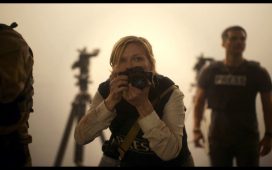Our latest Guardian documentary is filmed in the remote highlands of Papua New Guinea.
Tribal fighting has long been part of life in the region but the wide circulation of bootleg copies of the 1980s action film Rambo have been used as a crude tutorial on the use of automatic weapons, turning local disputes into lethal exchanges and reshaping highlands culture forever. In this film we meet fighters and peacekeepers trying to navigate a path between tradition and modernity.

Watch Guardian Documentary ‘Lost Rambos’ Photograph: Chris Phillips/The Guardian Documentaries
Click above to watch the film and read more below about how director Chris Phillips made the film.
Describe your creative approach to the story
The film attempts to explore the complexities of a culture which is often misunderstood rather than offer perfect solutions to deadly tribal fighting.
We touch on many themes: how difficult it is to maintain peace in a society out of the reach of state run law and order; how the influx of semi-automatic weapons has intensified tribal conflict; how gender inequality and toxic masculinity impact warfare; how cultural systems and ceremonies can prolong war and peace in small scale communities; and how difficult the journey can be for peace advocates even when the community acknowledges the suffering that fighting causes.
It was important to me that we capture multiple perspectives on the fighting to explore the motivation from various points of view. We also chose to use cinematic re-enactments as a storytelling device to give an insight into the young warrior’s perspective, which is often intoxicated with the grandeur of fighting. I reached out to the International Committee of the Red Cross who sponsor a local acting group for help. I was also surprised by the overwhelming enthusiasm of tribes in Kompiam to perform fighting demonstrations and ceremonies.

Your film celebrates the landscape as well as the culture of the highlands of Papua New Guinea. How did you become interested in the region?
My obsession with the remote highlands started in 2008 when one of my closest friends was working at the field hospital in Kompiam as part of his medical degree. After completing a clinic in a town called Yangis, he spent several days accommodated generously by the locals and much of the time was spent in deep conversation with the community, who talked about the experience of living in a town ripped apart by tribal fighting. I began accompanying him back to the town each year to visit the communities on both sides of the conflict and worked with a local NGO.
The visits were facilitated by Joseph Lakai who would arrange the logistics for our local travel which was always complicated due to persistent instability in Yangis. Joseph and I kept in contact via email in the following years.

So your friendship with Joseph was in some ways the key to this film?
Yes, years after first meeting Joseph, we got the terrible news that his own village of Kompiam had rapidly fallen into a huge tribal fight. The army had been called in, large numbers killed, and most of the town evacuated. For Joseph this was the worst-case scenario, his own tribe was central to the conflict and his efforts to call for peace had fallen on deaf ears.

Joseph could open up the story of the Tinalapin tribe to you, but what about the story of the opposing faction, the Sambe tribe?
The only story that Joseph could not facilitate was the refugees displaced by the conflict. We were looking for a family from the opposing tribe and felt we really needed a strong female voice. Given the Sambe were scattered in exile in the surrounding hills, this was always going to be the hardest story to access. However, in many ways it was the most important.
The family we eventually filmed with were extremely keen to tell their story but it was a tricky process. We sat in a small hut with the five women in front of the camera, and off camera to the side were three men sitting in on the interview. They were senior members of the village housing the refugees, and it soon became obvious that they were becoming irritated by the process.

The men couldn’t understand why we had chosen to talk to women about conflict. In their minds, conflict was a man’s game so they continued to interrupt the women’s answers and correct them. They were also disgruntled that we were focusing on a female perspective rather than the impact their displacement had on the surrounding tribes.
I often think of this family of refugees and every time I contact people in Kompiam I ask if the Sambe have returned to their land. They have not.
With no phones or addresses, I imagine even the simplest logistics can become extremely difficult. What was it was like filming there?
The remote highlands make for a compelling backdrop, but it’s not without difficulty. Obviously, there’s the logistical difficulties of being in a remote location, electrical power for just a handful of hours each day, lugging camera gear up mountains and into villages with no cars, communication difficulties, daily thunderstorms, and the confusion a drone can cause!

As well as the logistics, it must have been a challenge to navigate the cultural complexities
It was absolutely crucial that everyone in the community understood our vision and motivations for the film, and had a chance to register any concerns or questions, so I had always planned to reach all key tribal leaders instantly upon arrival.
When we finally arrived however, some of the most important elders were a few days walk away harvesting sweet potatoes, so it was suggested that it might be better if I made an attempt to reach the whole community together. With some local encouragement it was decided I should march straight down to the public marketplace, and make a speech to give the community a chance to ask any questions directly.
The crowd circled quickly and the nervy speech and Q&A took around 20 minutes. Eventually an older man came forward and announced that, as the senior member in attendance, he gave the project his blessing. We’d be free to move through their land – a major obstacle had been cleared.

Tell us a little bit about the film-making team
I feel incredibly lucky for the talented team we had making this film. Michaela Perske and Kiki Dillon are fabulous producers who navigated lots of complexity and are always upbeat.
Cinematographer Michael Latham actually grew up in Papua New Guinea, spending the first 12 years of his life in Mount Hagen, and we passed his primary school on one of our first days in the shoot.
Editor Dan Lee spent many late nights in the edit and the film certainly wouldn’t have reached the clarity it did without him. This type of post-production is full of complexities including working with translated dialogue.

Composer Aaron Cupples has an amazing ability to interpret the emotion of the footage and strike a delicate balance between subtle accompaniment and high impact moments. He researched instruments from Enga and ended up building his own “bamboo” flute from plastic hardware pipes.
Sound designer AJ Bradford made the jungle come alive sonically. It was a great thrill to launch the film in my hometown at the Melbourne international film festival and really feel the impact of his work in quality cinemas. And we were lucky enough to win the Best Short Documentary award at the festival!
Coming up: Nowt But a Fleeting Thing
An intimate film about a young farmer’s connection to the land, his animals and a rapidly changing world. Balancing knowledge passed down by his father Raymond, and his own experience in environmental conservation, Adam Crowe works hard to establish a life in farming that is sustainable for his family while supporting the fragile ecosystems of South Lakeland. Out November 2019














